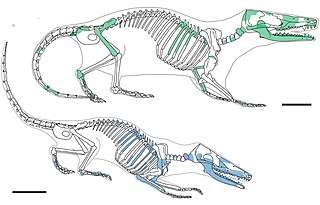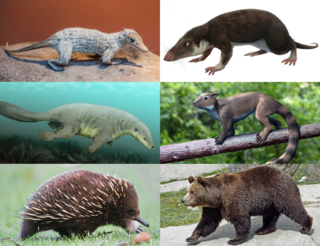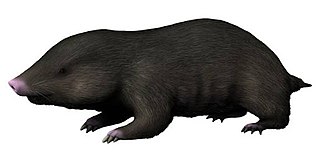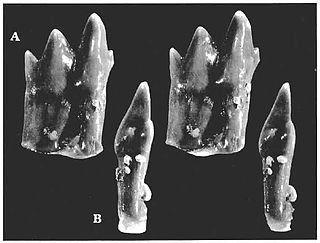
Barapasaurus is a genus of basal sauropod dinosaur from Jurassic rocks of India. The only species is B. tagorei. Barapasaurus comes from the lower part of the Kota Formation, which is of Early to Middle Jurassic age. It is therefore one of the earliest known sauropods. Barapasaurus is known from approximately 300 bones from at least six individuals, so that the skeleton is almost completely known except for the anterior cervical vertebrae and the skull. This makes Barapasaurus one of the most completely known sauropods from the early Jurassic.

Castorocauda is an extinct, semi-aquatic, superficially otter-like genus of docodont mammaliaforms with one species, C. lutrasimilis. It is part of the Yanliao Biota, found in the Daohugou Beds of Inner Mongolia, China dating to the Middle to Late Jurassic. It was part of an explosive Middle Jurassic radiation of Mammaliaformes moving into diverse habitats and niches. Its discovery in 2006, along with the discovery of other unusual mammaliaforms, disproves the previous hypothesis of Mammaliaformes remaining evolutionarily stagnant until the extinction of the non-avian dinosaurs.

Docodonta is an order of extinct Mesozoic mammaliaforms. They were among the most common mammaliaforms of their time, persisting from the Middle Jurassic to the Early Cretaceous across the continent of Laurasia. They are distinguished from other early mammaliaforms by their relatively complex molar teeth. Docodont teeth have been described as "pseudotribosphenic": a cusp on the inner half of the upper molar grinds into a basin on the front half of the lower molar, like a mortar-and-pestle. This is a case of convergent evolution with the tribosphenic teeth of therian mammals. There is much uncertainty for how docodont teeth developed from their simpler ancestors. Their closest relatives may have been certain Triassic "symmetrodonts", namely Woutersia, Delsatia, and Tikitherium.

Mammaliaformes is a clade that contains the crown group mammals and their closest extinct relatives; the group radiated from earlier probainognathian cynodonts. It is defined as the clade originating from the most recent common ancestor of Morganucodonta and the crown group mammals; the latter is the clade originating with the most recent common ancestor of extant Monotremata, Marsupialia, and Placentalia. Besides Morganucodonta and the crown group mammals, Mammaliaformes includes Docodonta and Hadrocodium as well as the Triassic Tikitherium, the earliest known member of the group.

Docodon is an extinct docodont mammaliaform from the Late Jurassic of western North America. It was the first docodont to be named.

Kuehneotherium is an early mammaliaform genus, previously considered a holothere, that lived during the Late Triassic-Early Jurassic Epochs and is characterized by reversed-triangle pattern of molar cusps. Although many fossils have been found, the fossils are limited to teeth, dental fragments, and mandible fragments. The genus includes Kuehneotherium praecursoris and all related species. It was first named and described by Doris M. Kermack, K. A. Kermack, and Frances Mussett in November 1967. The family Kuehneotheriidae and the genus Kuehneotherium were created to house the single species Kuehneotherium praecursoris. Modeling based upon a comparison of the Kuehneotherium jaw with other mammaliaforms indicates it was about the size of a modern-day shrew between 4 and 5.5 g at adulthood.

Docofossor is an extinct mammaliaform from the Jurassic period. Its remains have been recovered in China from 160 million years old rocks. It appears to have been the earliest-known subterranean mammaliaform, with adaptations remarkably similar to the modern Chrysochloridae, the golden moles.
Tegotherium is an extinct mammaliaform from the Late Jurassic of East Asia. The type species T. gubini is known from the Shar Teeg Beds of Mongolia and an indeterminate species is also known from the Late Jurassic Qigu Formation of China. It belongs to the clade Docodonta.

Dyskritodon is a genus of extinct mammal from the Early Cretaceous of Morocco, and possibly the Early Jurassic of India. Of uncertain affinities, it is tentatively described as a eutriconodont.

Borealestes is a genus of docodontan from the Middle Jurassic of Britain, first discovered on the Isle of Skye near the village of Elgol. It was the earliest mammaliaform from the Mesozoic found and named in Scotland. A second species and was later found in other Middle Jurassic sites in England, but is now shown to be a different genus. A new species, B. cuillinensis was named in 2021, also from Skye.
Wareolestes rex is a mammaliaform from the Middle Jurassic (Bathonian) rocks of England and Scotland. It was originally known from isolated teeth from England, before a more complete jaw with teeth was found in the Kilmaluag Formation of Skye, Scotland.
Vilevolodon is an extinct, monotypic genus of volant, arboreal euharamiyids from the Oxfordian age of the Late Jurassic of China. The type species is Vilevolodon diplomylos. The genus name Vilevolodon references its gliding capabilities, Vilevol, while don is a common suffix for mammalian taxon titles. The species name diplomylos refers to the dual mortar-and-pestle occlusion of upper and lower molars observed in the holotype; diplo, mylos.
Cifelliodon is an extinct genus of mammaliaforms from the Lower Cretaceous of North America. In the describing paper, it was considered one of the latest surviving haramiyids yet known, belonging to the family Hahnodontidae. Its discovery led to the proposal to remove hahnodontids from the larger well-known group, the multituberculates. However, later papers have considered it to be a basal allotherian outside of Haramiyida.
Peraiocynodon is an extinct mammaliaform from the order Docodonta, found in the Middle Jurassic rocks of the United Kingdom. It is only known from isolated molar teeth found in the mammal bed at Kirtlington cement quarry in Oxfordshire, England.
Cyrtlatherium is a dubious genus of extinct docodontan mammaliaform from the Middle Jurassic rocks of Oxfordshire, England. As it is only known from a few isolated molar teeth, there is disagreement about whether Cyrtlatherium is a separate genus, or whether it is a synonym and the molar teeth are the milk teeth of another genus of docodont.
Krusatodon is a genus of extinct docodont mammaliaform from the Middle Jurassic of the United Kingdom. It is known from the Forest Marble Formation, Kirtlington, in England, and also from a single molar tooth in the Kilmaluag Formation on the Isle of Skye, Scotland.
Simpsonodon is an extinct genus of docodontan mammaliaform known from the Middle Jurassic of England, Kyrgyzstan and Russia. The type species S. oxfordensis was described from the Kirtlington Mammal Bed and Watton Cliff in the Forest Marble Formation of England. It was named after George Gaylord Simpson, a pioneering mammalologist and contributor to the Modern Evolutionary Synthesis. A second species S. sibiricus is known from the Itat Formation of Russia, and indeterminate species of the genus are also known from the Balabansai Formation in Kyrgyzstan
Itatodon is an extinct genus of primitive mammaliaforms known from the Bathonian aged Itat Formation of Russia. The genus is named after the formation, with the species being named after Leonid Petrovich Tatarinov who described the first docodont from Asia. It is known from a holotype right lower molar and referred isolated right lower molar and fragment of the left lower molar. When it was first described, it was thought to be a docodontan, but one recent phylogenetic studies have assigned it, along with its close relative Paritatodon to Shuotheriidae, while others continue to consider it a docodont.
Microdocodon is a genus of docodontan mammaliaform from the Late Jurassic Yanliao Biota. It contains only a single species, Microdocodon gracilis, known from the Daohugou locality. It is unique for preserving the hyoid bone, which is almost unknown in the early mammal fossil record.
Indotherium is an extinct genus of mammaliaforms that lived in what is now India during the Early Jurassic. It contains one species, I. pranhitai, which is known from two upper molar teeth found in the Kota Formation of Telangana. When it was first described, it was assigned to the paraphyletic group "Symmetrodonta", but later studies have reinterpreted it as a possible member of the family Morganucodontidae.













